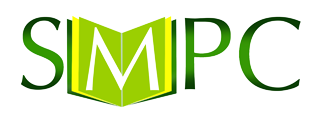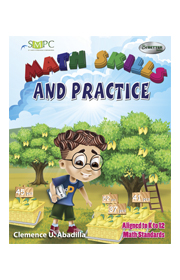
by Clemence U. Abadilla
The concepts under each unit are developed in three stages. The learners are given ample opportunities to relate the concept to what they do ordinarily, summarize the concept in a language easy to understand and recite. Then they are given varied assessment activities to test the mastery of the concept.
Using this book gives the five year old an enjoyable and challenging opportunity to acquire the concepts under the new mathematics curriculum of Kinder to 12 program.
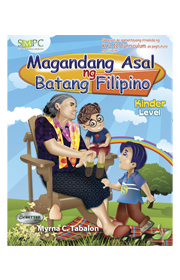
by Myrna C. Tabalon
Ang mga aralin sa Kagandahang Asal para sa antas ng kinder ay nagsisimula sa pagkilala ng mag-aaral sa kanyang sarili at sa lipunang kanyang ginagalawan.
Ang unang yunit ay tungkol sa kanyang pagkakakilanlan. Ang unang kamalayan niya sa kanyang sarili ay ang pangalan at apelyido niya. Ang mga kasunod pang aralin ay nakapokus sa kanyang mga kakayahan at katangian. Maagang iminumulat sa kanyang na kaya niyang linangin ang kanyang mga kakayahan at katangian upang makatulong at makaambag sa pag-unlad ng sariling pamilya at ang papalawak na kapaligiran na kanyang ginagalawan.
Sa kanyang murang edad, ginigising ang kanyang kamalayan sa kapaligirang panlipunan at pisikal. Kung paano niya pangangalagaan ang kapaligiran ang magiging batayan kung gaano magiging masaya at maunlad ang sariling pamilya at barangay. Ito ang mga pokus ng aralin sa dalawang huling yunit ng aklat.
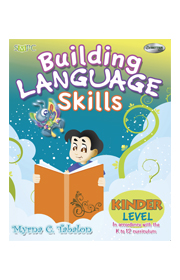
by Myrna C. Tabalon
This book is primarily designed to help young learners express their ideas and feelings in English. It can be initially acquired by developing in them, good listening and speaking skills. A number of activities in this book involves listening to poem identifying sentence patterns, and content words. Hopefully, these experiences will result in a listening and speaking vocabulary necessary in attaining the children’s facility and confidence in expressing themselves in English.
Language facility involves the mastery of the basic rules. The grammar lessons in this book are presented in a clear format that utilizes both inductive and deductive thinking. Grammar comes alive as the young learners discover and apply correct usage in familiar situations.
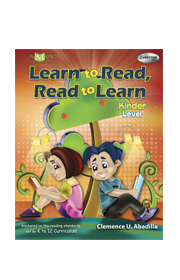
By Clemence U. Abadilla.
The reading material - Learn to Read and Read to Learn establishes the foundation for a functional reading program as embodied in the reading standards of the K to 12 Curriculum. It starts with an alphabet knowledge of the English language. English as a language has its orthography and the young learners are introduced to the phonological skills of learning the names and sounds of the letters of the alphabet, gradually going up to the phonological levels of syllables and phonemes and the high-frequency sight words. These lessons are in the first stage of learning to read. In the phase read to learn, the young learners locate information, recognize key ideas and organize information from short and interesting stories. The young learners are now in the stage of using text information for variety of purposes.
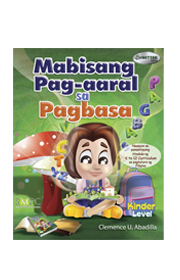
By Clemence U. Abadilla.
Ang batayan at pangunahing layunin sa pagtuturo ng Filipino ay makalinang at makabuo ng isang mamamayan may ganap na literasi na ang payak na kahulugan ay isang Filipino na marunong bumasa at umunawa sa kanyang katutubong wika. Kaugnay nito ay ang kakayahang magpahayag ng ideya at damdamin sa sariling wika at maisulat ito sa anyo na mauunawaan ng babasa.
Tungo sa ikatutupad ng layuning ito, inihanda ang aklat na ito sa mga aralin na makikilala ng mag-aaral ang mga pangalan at tunog ng alpabeto; makabuo ng makabuluhang salita sa pamamagitan ng pagsasama ng mga titik. Nagtatapos ang ganitong aralin sa pagsasama ng mga salita upang makabuo ng pangungusap na naipapahayag ng mag-aaral ang kanyang naiisip at nadarama.
Naglalaman din ang aklat ng maiikli at kawiliwiling kwentong bayan na maglilinang sa kanya ng makabuluhang pagpapahalagang pampanitikan. Naglalaman din ang aklat ng mga gawaing lilinang sa mag-aaral na maisulat nang maayos ang kanyang naiisip at nadarama.
Maingat na inihanda ng St. Mary’s Publishing Corporation ang aklat na ito sa ikatutupad ng layunin at pamantayan ng K to 12 Curriculum sa pagtuturo ng Filipino.
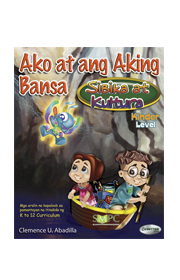
By Clemence U. Abadilla
Ang mga aralin sa Sibika at Kultura para sa antas ng kinder ay nagsisimula sa pagkilala ng mag-aaral sa kanyang sarili at sa lipunang kanyang ginagalawan.
Ang unang yunit ay tungkol sa kanyang pagkakakilanlan. Ang unang kamalayan niya sa kanyang sarili ay ang pangalan at apelyido niya. Ang mga kasunod pang aralin ay nakapokus sa kanyang mga kakayahan at katangian. Maagang iminumulat sa kanyang na kaya niyang linangin ang kanyang mga kakayahan at katangian upang makatulong at makaambag sa pag-unlad ng sariling pamilya at ang papalawak na kapaligiran na kanyang ginagalawan.
Sa kanyang murang edad, ginigising ang kanyang kamalayan sa kapaligirang panlipunan at pisikal. Kung paano niya pangangalagaan ang kapaligiran ang magiging batayan kung gaano magiging masaya at maunlad ang sariling pamilya at barangay. Ito ang mga pokus ng aralin sa dalawang huling yunit ng aklat.
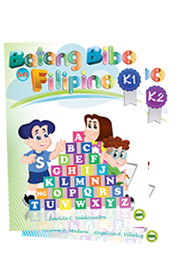
Nina Clotilde A. Madera, Angelica A. Villaluz, Emelita C. Valdecantos
Ang Batang Bibo sa Filipino ay inihanda para sa iyo upang mapalawak ang iyong kaalaman at matutuhan mo ang wastong pagbigkas at pagbasa ng mga titik, pantig, salita, at mga payak na pangungusap.
Layon din ng aklat na ito na mabigyan ka ng wasto at angkop na kasanayan sa pag-unawa sa pamamagitan ng mga larawan at kuwento. Sa mga aralin, lilinagin ng iyong kakayahan tungo sa mas malawak pang mga gawain. Ang mga pagsasanay ay iniangkop sa iyong karanasan upang maging kawili-wili at kasiya-siya ang pag-aaral.
Ayon sa batayang kasanayan sa Pagkatuto sa Pagbasa ng Department of Education, ang nilalaman ng aklat na ito, upang matugunan ang lahat ng inaasahang pag-unlad ng isang batang tulad mo. Kaya’t halinang mag-aral magbasa!
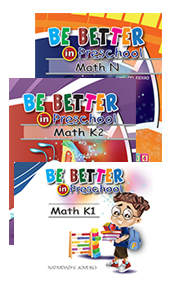
By Jong Del Fierro, Natividad V. Jovero, Clotilde A. Madera, Angelica A. Valdecantos
Modern thinking concerning mathematics has made it clear that basic mathematical concepts must be introduced as early as possible. this book was written with objective of giving the child a sound foundation for learning and appreciating mathematical ideas and skills that he can master and use in this modern world.
The activities are planned for guided developmental work with children work with children and has been chosen to suit the level and interest of learners who are just awakening to the wondered of numbers.
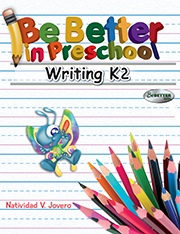
By Natividad V. Jovero
Knowledge explosion during the second half of the past century had drastically shortened the waiting time for children to attain readiness for various skills in the school program. As a consequence, pupils" readiness in skills such as writing comes at an earlier age.
The author offers in this book activities arranged according to complexity, which would further hasten the writing development of children. The systematic presentation of basic strokes in writing, followed by exercises that enhance the skills involved, would help enable the learners to achieve more in the shortest time possible.
Knowledge explosion during the second half of the past century had drastically shortened the waiting time for children to attain readiness for various skills in the school program. As a consequence, pupils" readiness in skills such as writing comes at an earlier age.
The author offers in this book activities arranged according to complexity, which would further hasten the writing development of children. The systematic presentation of basic strokes in writing, followed by exercises that enhance the skills involved, would help enable the learners to achieve more in the shortest time possible.
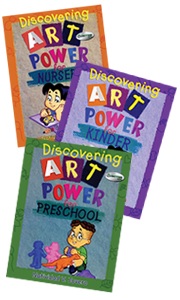
By Natividad V. Jovero
The series is designed as an attempt to share with children, young as they are experiences in the visuals
Children may work directly or attach some of their work on the pages provided in the book. For some lessons, though, they are advised to sketch or use a photograph of the lesson output
Discovering Art Power features art activities that are fun and easy to do. Parents and teachers are encouraged to help guide their children in discovering art, its beauty and the power of self expression in it.
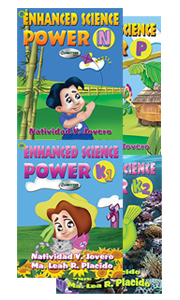
(N, K1, K2 and P)
by Natividad V. Jovero, Louie Placido, Ma. Leah Placido
The series gives an opportunity to young learners to understand and experience the world and all the things in and around it. There are activities and exercises that will teach learners on how to observe carefully - how to compare, classify, and describe what they see. A checkup time is also included which will be exercises to find out how well the children have learned their lesson.

By Clemence U. Abadilla
The Department of Education has long recognized the importance of early childhood education as a first stage of a more rigorous formal education. Many studies support the principle that the ages 4 and 5 are the period of greatest brain development. When immersed in communication activities, social interactions, and plays and games, children aged 4-6 develop self-worth, comprehend cognitive concepts, number sensitivity and appreciate family values. The enactment of Republic Act No. 10157 or the Kindergarten Education Act is a milestone in the education system.
In consonance with the Kindergarten Curriculum Framework the lessons in this book are presented as learning experiences around the child as a person and as a member of his family, school and community. He comprehends cognitive concepts, values the people and environment around him, appreciates social and spiritual values as he listens to stories, shares experiences, recites poems, plays games with his peers and constructs simple projects.
The author believes that using this book the child becomes an emergent, literate boy or girl
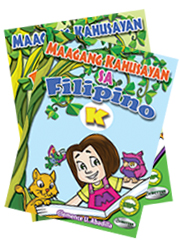
Ni Clemence U. Abadilla
Nagsisimula ang kahandaang bumasa ng isang bata mula sa panahong siya ay magkaisip hanggang makakilala ng salitang nakalimbag. Hindi pisikal o intelektwal na pagkatuto lamang ang pagbasa. Hindi rin naman dapat palipasin ang matagal na panahon bago turuang bumasa ang bata. Ito ang pangunahing layunin ng aklat na Maagang Kahusayan sa Filipino – ang tulungang matutong bumasa ang bata sa patnubay ng guro at tulong ng magulang.
Nakapaloob sa mga aralin ang mga sumusunod:
- Pagkatuto ng paghawak at paggamit ng krayola, lapis, at gunting
- Pagsunod sa mga pasalitang panuto
- Pakikinig at pagbigkas ng mga salita
- Pagkakaroon ng kasanayang makilala ang pagkakaiba ng mga titik at tunog ng mga ito
- Pagbibigay ng kahulugan sa mga larawan
- Pagkakaroon ng ganap na kawilihan sa pag-unawa ng salitang nakalimbag
- Pagtukoy sa pagkakasunod-sunod ng mga pangyayari sa kwento
Inaasahang matatamo ng guro at ng mag-aaral ang masaya, makabuluhan, at kapaki- pakinabang na karanasan sa pag-aaral ng wikang Filipino.
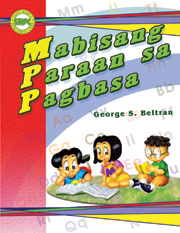
by George S. Beltran
Ang Mabisang Paraan sa Pagbasa ay inihanda para matuto ang mga mag-aaral ang pagbabasa, wastong pagbigkas ng mga titik, pantig, salita at mga pangungusap. Ang mga aralin sa aklat na ito ay ini-angkop sa kakayahan ng mga mag-aaral at masusing isinaayos ayon sa antas ng kahirapan. Upang maging kawili-wili sa bata ang pag-aaral, ipinaloob din ang mga kwentong nagbibigay aliw at aral.
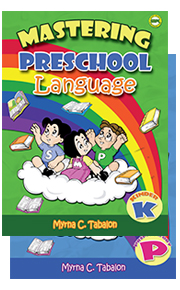
by Myrna C. Tabalon
This book is primarily designed to help young learners express their ideas and feelings in a second language. English as a second language can be initially acquired by developing in them good listening and speaking skills. A number of activities in this book involve listening to poems, sentence patterns, and content words. Hopefully, these experiences will result in a listening and speaking vocabulary necessary in attaining the children’s facility and confidence in expressing themselves in English.
Language facility involves the mastery of the basic rules. The grammar lessons in this book are presented in a clear format that utilizes both inductive and deductive thinking. Grammar comes alive as the young learners discover and apply correct usage in familiar situations.
In addition, children learn best through concrete experiences guided by a teacher. Their learning is enhanced further through a solid foundation for language facility in a second language.
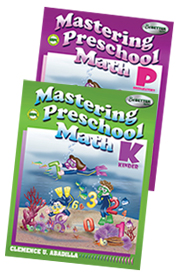
by Clemence U. Abadilla
Mastering Preschool Math Series was designed to provide the young learners with an adequate background on the basic concepts of elementary mathematics. The concepts are explained in an easy, nontechnical language supplemented by functional illustrations and challenging practice work.
The content of the series is based on the preschool education curriculum of the Department of Education. The young learners are introduced to the numeration system using the concepts of set and place value. Also, computational efficiency is achieved through quick recognition and full understanding of numbers. The other features of the book include the different geometric shapes, nonstandard and standard measurement units, and problem solving sets.
It is the desire of the author to present the concepts of elementary mathematics not as a composite of figures and formulas but as a useful and relevant tool for real-life application.
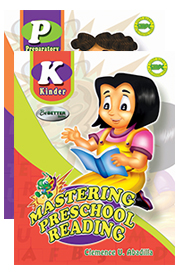
by Clemence U. Abadilla
The prereading period starts in early childhood, when a child can already be taught to recognize and read words. Readiness to read is neither physical nor intellectual maturation. Readiness to read is not something to wait for passively. It is a period into which a child may be guided by the teacher and the parent.
The lessons in this worktext aim to offer a systematic prereading experience to preschool learners. The importance of developing readiness for any reading experience at any level cannot be overlooked. When a child is not prepared to do a reading task, his/her frustrations produce a negative effect on learning.
This worktext contains a variety of reading readiness activities on:
- Handling crayons, pencils, and
- Understanding and speaking words
- Following oral directions
- Interpreting pictures
- Acquiring skills in perceiving sight and sound differences
- Following cumulative development of a story
- Developing interest in printed words
This worktext hopefully would become a useful and interesting tool for both the teacher and learners in this happy‰ experience of prereading and learning. scissors
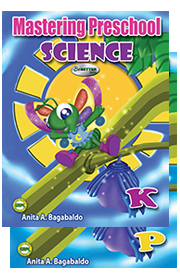
by Anita A. Bagabaldo
Mastering Preschool Science is especially written for beginning learners, following the preschool education curriculum standards of the Department of Education. It has the primary objectives of developing the young learners’ sensory perception skills and understanding of the basic science concepts pertaining to living and nonliving things in their surroundings.
Contents are grouped into Four Units – Objects and Materials in their Surroundings, People, Animals, and Plants.
Lessons are presented in easy and interesting activities aided by clear, easily interpreted illustrations, and with a short summary of the concepts learned placed at the bottom of each lesson page.
Exercises and activities intended to enrich the learning are provided in the Do and Learn part of the book where pupils work on independently.
Parents are encouraged to follow up their children’s learning through the Do This at Home part where they are asked to check and sign their children’s work.
Check-up Time is also a part provided to assess and evaluate the learning after several lessons.
This book is hoped to awaken the interest and curiosity of the child in the exploration and application of the wonders of science in this early stage of learning.
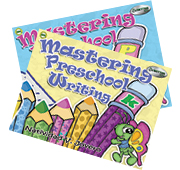
by Natividad V. Jovero
Mastering Preschool Writing is an early education series designed to aid the teacher in the process of developing the basic writing skills of preschool learners.
This book is intended to teach the child how to make the different strokes when doing letter forms in words, phrases, and sentences. Moreover, it is focused on developing writing control and coordination as well as correct writing posture.
It also provides exercises that will develop the child‘s hand muscle control by tracing lines, shapes, and objects, connecting dots and lines, and copying strokes and letters. These will serve as the springboard to letter formation.
The presentation of the letter formation is not done in alphabetical order. Simple curved letters are presented first, followed by the complicated curved letters.
The author is proud to share with the teachers and learners the product of her effort to make the teaching of writing more meaningful and relevant. It is hoped that the teachers and parents would collaborate to make every writing activity purposeful and enjoyable to children.

by Rosario R. Beltran Ed. D
Power in Preschool Language aims to develop the basic skills in listening and speaking. The lessons are arranged systematically with examples and activities that provide the child with functional and creative speaking experiences that helps the child to be socially responsive.
The series includes letters in name words and words in place of name words; doing words, describing words; and special words (is-are, a-an, this-that, etc)
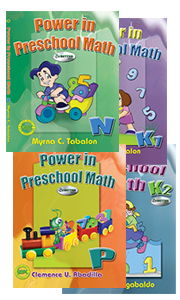
By Myrna C. Tabalon, Anita A. Bagabaldo, Clemence U. Abadilla
Recent research concerning mathematics has made it clear that basic mathematical concepts must be introduced as early as possible. This book was written with the objective of giving the child a sound foundation for learning, mastering, and appreciating mathematical ideas and skills he or she can use in this modern world.
The lessons are planned for guided developmental activities with children. These have been chosen carefully to suit the level and interest of learners who are just awakening to the wonders of numbers.
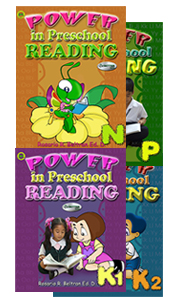
by Rosario R. Beltran Ed. D
Power in Preschool Reading is especially made for young children to help them develop the basic skills in listening, reading, and writing. Opportunity for auditory discrimination is enhanced through repetition, rhythmic language patterns and familiar concepts.
This series specifically includes activities for visual discrimination and classification activities for letter (alphabet) and word recognition; activities on letter sound recognition for nursery level activities for reading and writing three-letter word for K; activities for consonant blends, diagraph; activities for reading words, phrases, sentences, rhymes and stories for Kinder 2 and Prep.
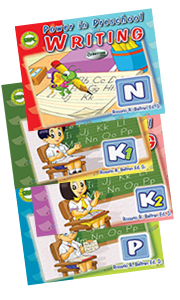
by Rosario R. Beltran Ed. D Power in Preschool Writing is for the children’s readiness in the basic skills that comes at an early age. Lessons are arranged according to complexity intended to hasten the writing development of the children. These lessons are followed by exercises that will reinforce the learning presented. The series is highlighted by exercises on eye and hand coordination which focused on strokes (lines and curves); letters (small and capital); words and sentence writing (for K2 and Prep); and numbers

by Zenaida Z. Tolentino, Angelita A. Bagabaldo, Myrna C. Tabalon
The modern concept of readiness for any learning task holds that readiness is not a waiting stage. The child is carefully guided into a series of planned and relevant activities at home and in school. Thus, developing readiness is an important function of parents and teachers
Readiness skills in reading is often called the prereading period when a child is taught to recognize and read words that express his ideas and feelings. The materials and activities in this section of the book are directed toward that task. In this book, the child learns to:
- understand the meaning of words heard and use them
- study and interpret pictures
- acquire the skill in perceiving relationships between letter sounds and printed letters
- follow oral directions
- follow the cumulative development of a story heard or read
- develop genuine interest in printed words
When a teacher uses this book, the readiness skills grow gradually until the child reaches the stage of readiness for formal reading.
